NUR231 Case Study Response Template
VerifiedAdded on 2022/08/21
|8
|2455
|10
AI Summary
Contribute Materials
Your contribution can guide someone’s learning journey. Share your
documents today.
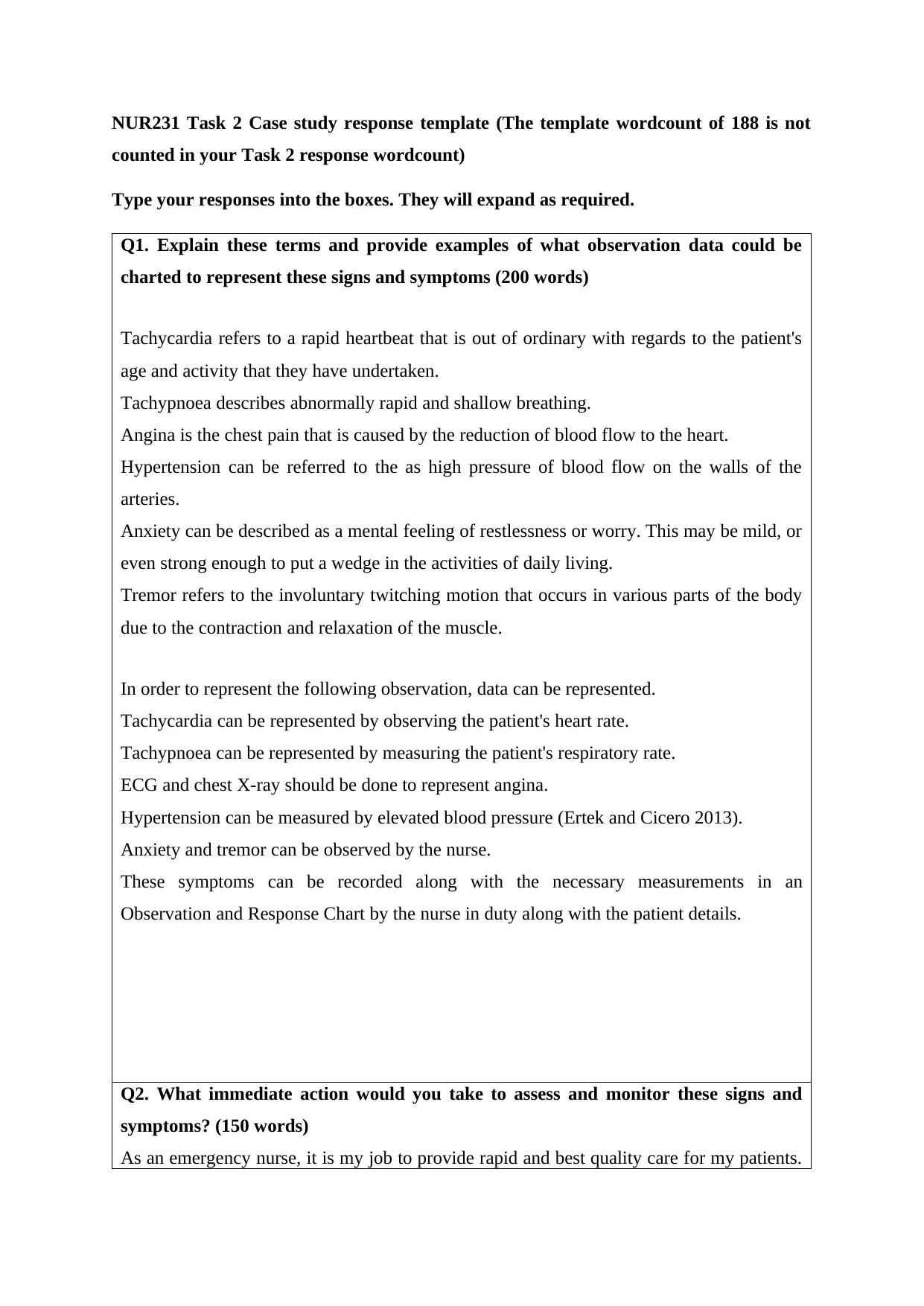
NUR231 Task 2 Case study response template (The template wordcount of 188 is not
counted in your Task 2 response wordcount)
Type your responses into the boxes. They will expand as required.
Q1. Explain these terms and provide examples of what observation data could be
charted to represent these signs and symptoms (200 words)
Tachycardia refers to a rapid heartbeat that is out of ordinary with regards to the patient's
age and activity that they have undertaken.
Tachypnoea describes abnormally rapid and shallow breathing.
Angina is the chest pain that is caused by the reduction of blood flow to the heart.
Hypertension can be referred to the as high pressure of blood flow on the walls of the
arteries.
Anxiety can be described as a mental feeling of restlessness or worry. This may be mild, or
even strong enough to put a wedge in the activities of daily living.
Tremor refers to the involuntary twitching motion that occurs in various parts of the body
due to the contraction and relaxation of the muscle.
In order to represent the following observation, data can be represented.
Tachycardia can be represented by observing the patient's heart rate.
Tachypnoea can be represented by measuring the patient's respiratory rate.
ECG and chest X-ray should be done to represent angina.
Hypertension can be measured by elevated blood pressure (Ertek and Cicero 2013).
Anxiety and tremor can be observed by the nurse.
These symptoms can be recorded along with the necessary measurements in an
Observation and Response Chart by the nurse in duty along with the patient details.
Q2. What immediate action would you take to assess and monitor these signs and
symptoms? (150 words)
As an emergency nurse, it is my job to provide rapid and best quality care for my patients.
counted in your Task 2 response wordcount)
Type your responses into the boxes. They will expand as required.
Q1. Explain these terms and provide examples of what observation data could be
charted to represent these signs and symptoms (200 words)
Tachycardia refers to a rapid heartbeat that is out of ordinary with regards to the patient's
age and activity that they have undertaken.
Tachypnoea describes abnormally rapid and shallow breathing.
Angina is the chest pain that is caused by the reduction of blood flow to the heart.
Hypertension can be referred to the as high pressure of blood flow on the walls of the
arteries.
Anxiety can be described as a mental feeling of restlessness or worry. This may be mild, or
even strong enough to put a wedge in the activities of daily living.
Tremor refers to the involuntary twitching motion that occurs in various parts of the body
due to the contraction and relaxation of the muscle.
In order to represent the following observation, data can be represented.
Tachycardia can be represented by observing the patient's heart rate.
Tachypnoea can be represented by measuring the patient's respiratory rate.
ECG and chest X-ray should be done to represent angina.
Hypertension can be measured by elevated blood pressure (Ertek and Cicero 2013).
Anxiety and tremor can be observed by the nurse.
These symptoms can be recorded along with the necessary measurements in an
Observation and Response Chart by the nurse in duty along with the patient details.
Q2. What immediate action would you take to assess and monitor these signs and
symptoms? (150 words)
As an emergency nurse, it is my job to provide rapid and best quality care for my patients.
Secure Best Marks with AI Grader
Need help grading? Try our AI Grader for instant feedback on your assignments.
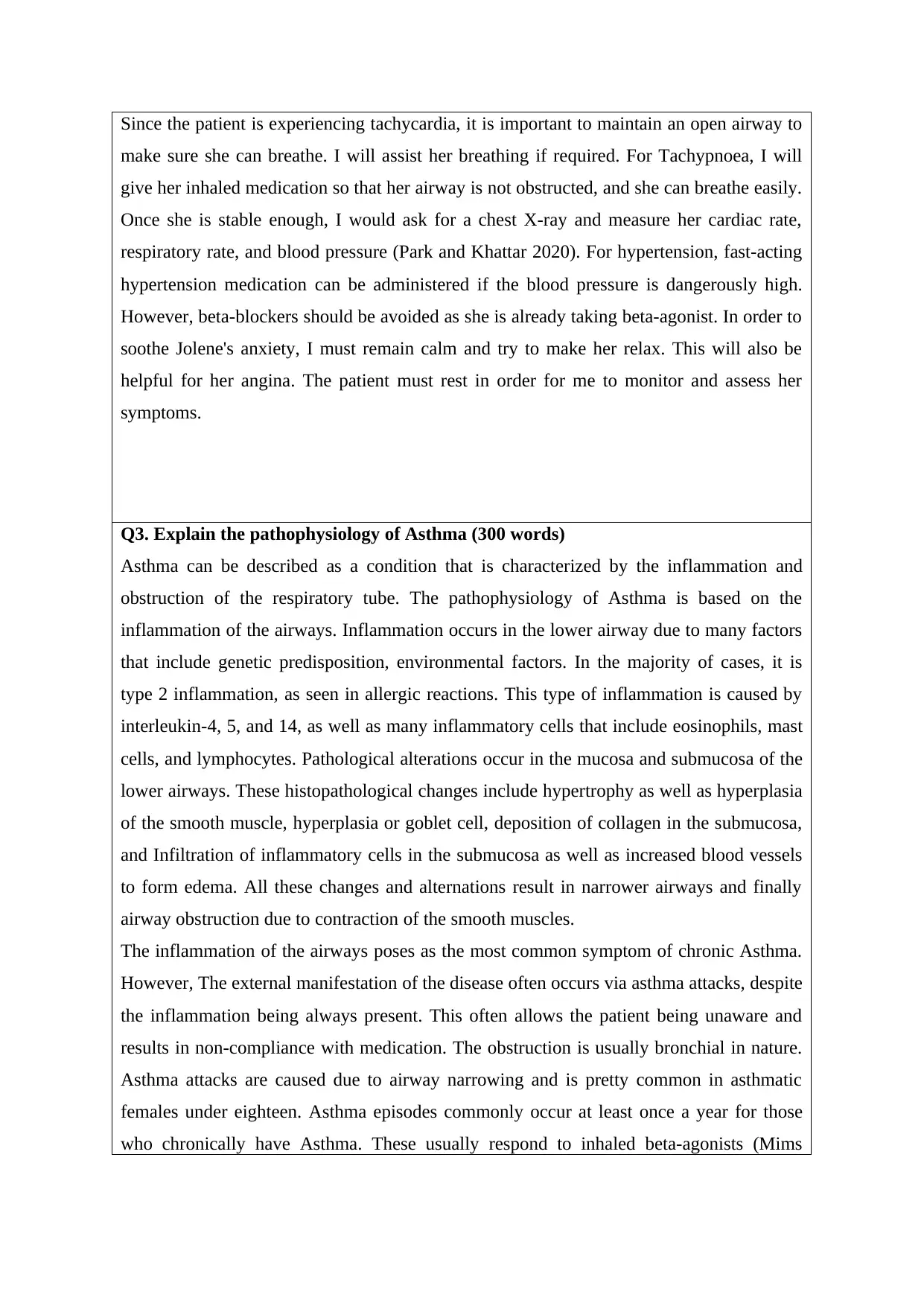
Since the patient is experiencing tachycardia, it is important to maintain an open airway to
make sure she can breathe. I will assist her breathing if required. For Tachypnoea, I will
give her inhaled medication so that her airway is not obstructed, and she can breathe easily.
Once she is stable enough, I would ask for a chest X-ray and measure her cardiac rate,
respiratory rate, and blood pressure (Park and Khattar 2020). For hypertension, fast-acting
hypertension medication can be administered if the blood pressure is dangerously high.
However, beta-blockers should be avoided as she is already taking beta-agonist. In order to
soothe Jolene's anxiety, I must remain calm and try to make her relax. This will also be
helpful for her angina. The patient must rest in order for me to monitor and assess her
symptoms.
Q3. Explain the pathophysiology of Asthma (300 words)
Asthma can be described as a condition that is characterized by the inflammation and
obstruction of the respiratory tube. The pathophysiology of Asthma is based on the
inflammation of the airways. Inflammation occurs in the lower airway due to many factors
that include genetic predisposition, environmental factors. In the majority of cases, it is
type 2 inflammation, as seen in allergic reactions. This type of inflammation is caused by
interleukin-4, 5, and 14, as well as many inflammatory cells that include eosinophils, mast
cells, and lymphocytes. Pathological alterations occur in the mucosa and submucosa of the
lower airways. These histopathological changes include hypertrophy as well as hyperplasia
of the smooth muscle, hyperplasia or goblet cell, deposition of collagen in the submucosa,
and Infiltration of inflammatory cells in the submucosa as well as increased blood vessels
to form edema. All these changes and alternations result in narrower airways and finally
airway obstruction due to contraction of the smooth muscles.
The inflammation of the airways poses as the most common symptom of chronic Asthma.
However, The external manifestation of the disease often occurs via asthma attacks, despite
the inflammation being always present. This often allows the patient being unaware and
results in non-compliance with medication. The obstruction is usually bronchial in nature.
Asthma attacks are caused due to airway narrowing and is pretty common in asthmatic
females under eighteen. Asthma episodes commonly occur at least once a year for those
who chronically have Asthma. These usually respond to inhaled beta-agonists (Mims
make sure she can breathe. I will assist her breathing if required. For Tachypnoea, I will
give her inhaled medication so that her airway is not obstructed, and she can breathe easily.
Once she is stable enough, I would ask for a chest X-ray and measure her cardiac rate,
respiratory rate, and blood pressure (Park and Khattar 2020). For hypertension, fast-acting
hypertension medication can be administered if the blood pressure is dangerously high.
However, beta-blockers should be avoided as she is already taking beta-agonist. In order to
soothe Jolene's anxiety, I must remain calm and try to make her relax. This will also be
helpful for her angina. The patient must rest in order for me to monitor and assess her
symptoms.
Q3. Explain the pathophysiology of Asthma (300 words)
Asthma can be described as a condition that is characterized by the inflammation and
obstruction of the respiratory tube. The pathophysiology of Asthma is based on the
inflammation of the airways. Inflammation occurs in the lower airway due to many factors
that include genetic predisposition, environmental factors. In the majority of cases, it is
type 2 inflammation, as seen in allergic reactions. This type of inflammation is caused by
interleukin-4, 5, and 14, as well as many inflammatory cells that include eosinophils, mast
cells, and lymphocytes. Pathological alterations occur in the mucosa and submucosa of the
lower airways. These histopathological changes include hypertrophy as well as hyperplasia
of the smooth muscle, hyperplasia or goblet cell, deposition of collagen in the submucosa,
and Infiltration of inflammatory cells in the submucosa as well as increased blood vessels
to form edema. All these changes and alternations result in narrower airways and finally
airway obstruction due to contraction of the smooth muscles.
The inflammation of the airways poses as the most common symptom of chronic Asthma.
However, The external manifestation of the disease often occurs via asthma attacks, despite
the inflammation being always present. This often allows the patient being unaware and
results in non-compliance with medication. The obstruction is usually bronchial in nature.
Asthma attacks are caused due to airway narrowing and is pretty common in asthmatic
females under eighteen. Asthma episodes commonly occur at least once a year for those
who chronically have Asthma. These usually respond to inhaled beta-agonists (Mims
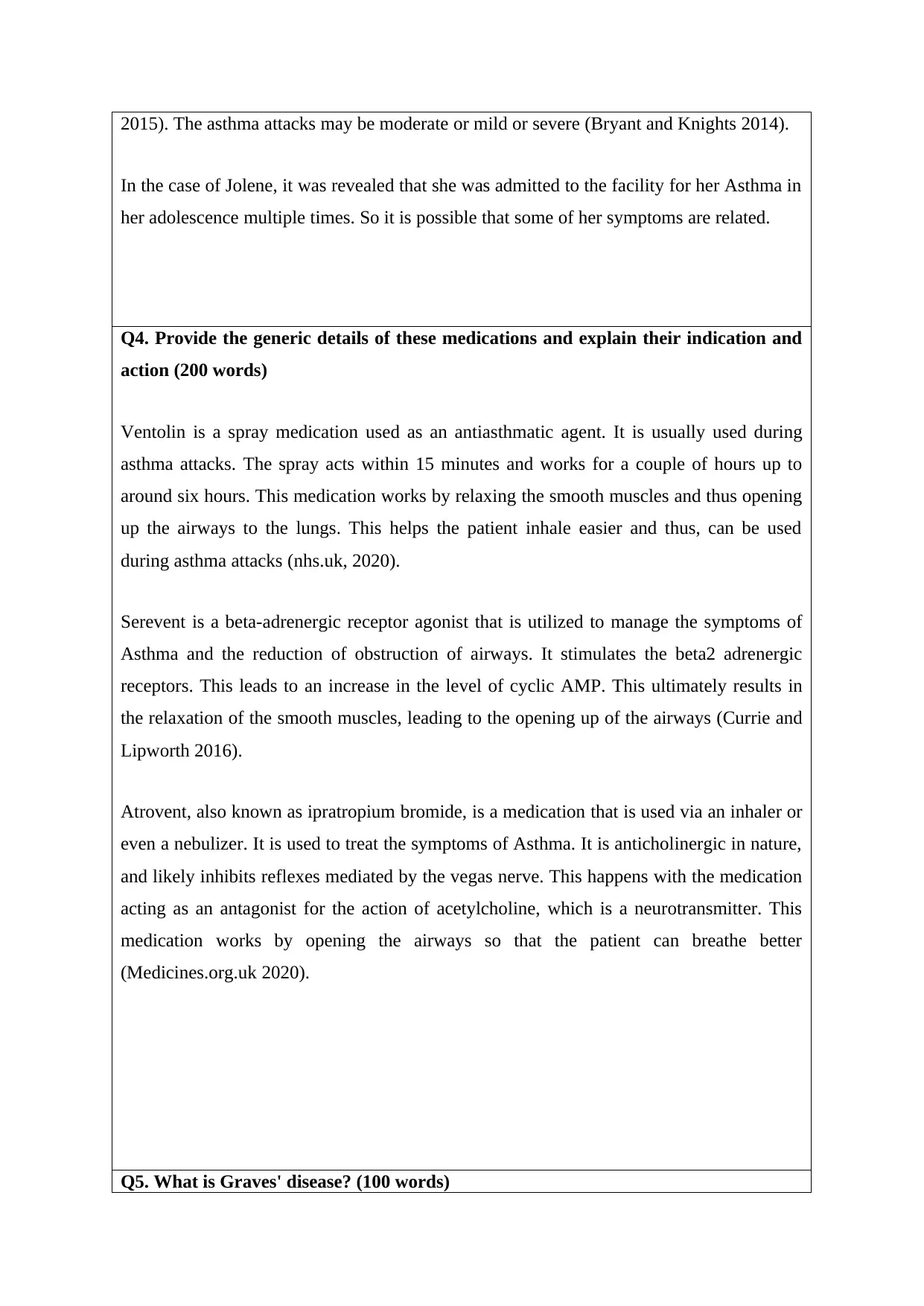
2015). The asthma attacks may be moderate or mild or severe (Bryant and Knights 2014).
In the case of Jolene, it was revealed that she was admitted to the facility for her Asthma in
her adolescence multiple times. So it is possible that some of her symptoms are related.
Q4. Provide the generic details of these medications and explain their indication and
action (200 words)
Ventolin is a spray medication used as an antiasthmatic agent. It is usually used during
asthma attacks. The spray acts within 15 minutes and works for a couple of hours up to
around six hours. This medication works by relaxing the smooth muscles and thus opening
up the airways to the lungs. This helps the patient inhale easier and thus, can be used
during asthma attacks (nhs.uk, 2020).
Serevent is a beta-adrenergic receptor agonist that is utilized to manage the symptoms of
Asthma and the reduction of obstruction of airways. It stimulates the beta2 adrenergic
receptors. This leads to an increase in the level of cyclic AMP. This ultimately results in
the relaxation of the smooth muscles, leading to the opening up of the airways (Currie and
Lipworth 2016).
Atrovent, also known as ipratropium bromide, is a medication that is used via an inhaler or
even a nebulizer. It is used to treat the symptoms of Asthma. It is anticholinergic in nature,
and likely inhibits reflexes mediated by the vegas nerve. This happens with the medication
acting as an antagonist for the action of acetylcholine, which is a neurotransmitter. This
medication works by opening the airways so that the patient can breathe better
(Medicines.org.uk 2020).
Q5. What is Graves' disease? (100 words)
In the case of Jolene, it was revealed that she was admitted to the facility for her Asthma in
her adolescence multiple times. So it is possible that some of her symptoms are related.
Q4. Provide the generic details of these medications and explain their indication and
action (200 words)
Ventolin is a spray medication used as an antiasthmatic agent. It is usually used during
asthma attacks. The spray acts within 15 minutes and works for a couple of hours up to
around six hours. This medication works by relaxing the smooth muscles and thus opening
up the airways to the lungs. This helps the patient inhale easier and thus, can be used
during asthma attacks (nhs.uk, 2020).
Serevent is a beta-adrenergic receptor agonist that is utilized to manage the symptoms of
Asthma and the reduction of obstruction of airways. It stimulates the beta2 adrenergic
receptors. This leads to an increase in the level of cyclic AMP. This ultimately results in
the relaxation of the smooth muscles, leading to the opening up of the airways (Currie and
Lipworth 2016).
Atrovent, also known as ipratropium bromide, is a medication that is used via an inhaler or
even a nebulizer. It is used to treat the symptoms of Asthma. It is anticholinergic in nature,
and likely inhibits reflexes mediated by the vegas nerve. This happens with the medication
acting as an antagonist for the action of acetylcholine, which is a neurotransmitter. This
medication works by opening the airways so that the patient can breathe better
(Medicines.org.uk 2020).
Q5. What is Graves' disease? (100 words)
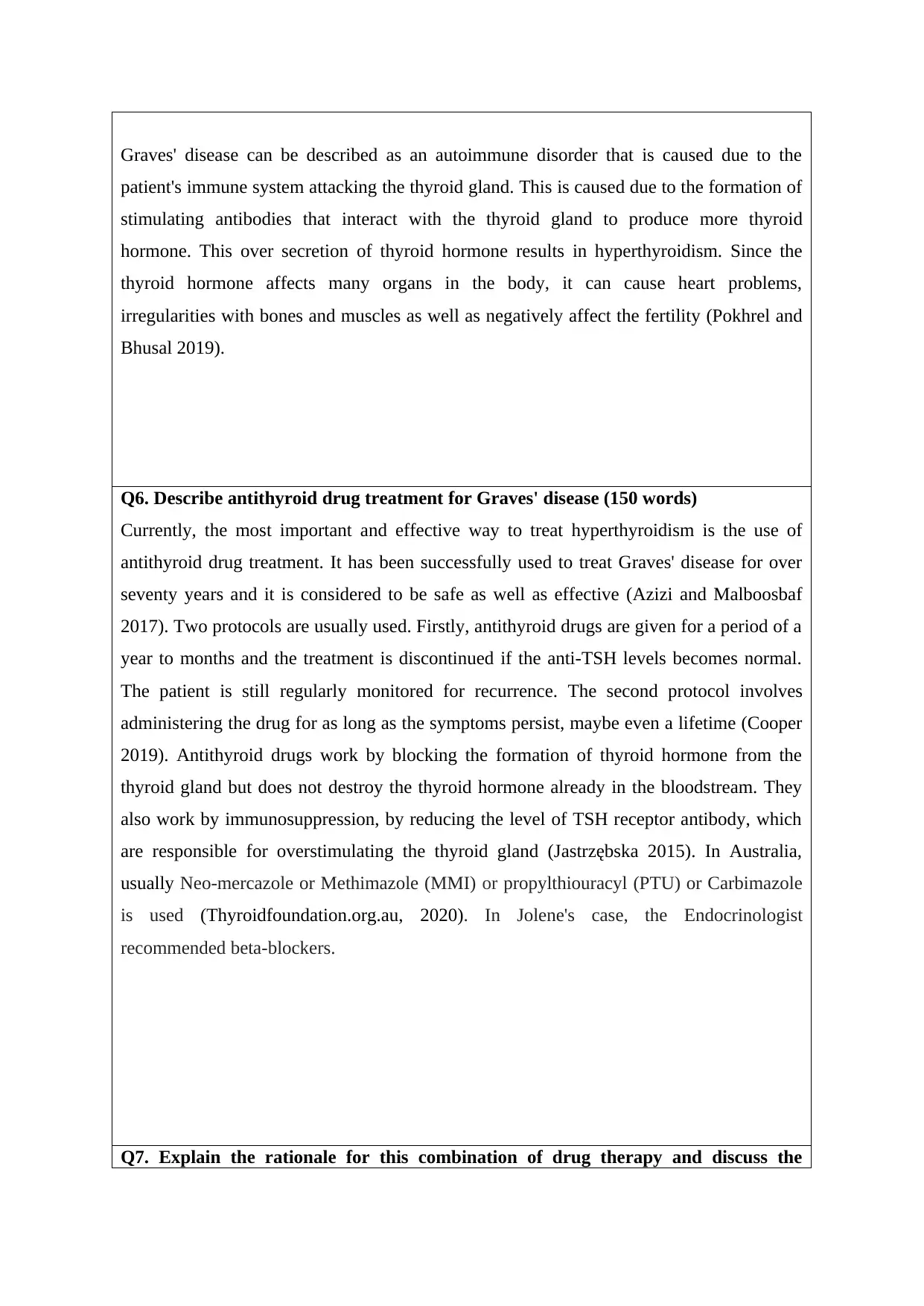
Graves' disease can be described as an autoimmune disorder that is caused due to the
patient's immune system attacking the thyroid gland. This is caused due to the formation of
stimulating antibodies that interact with the thyroid gland to produce more thyroid
hormone. This over secretion of thyroid hormone results in hyperthyroidism. Since the
thyroid hormone affects many organs in the body, it can cause heart problems,
irregularities with bones and muscles as well as negatively affect the fertility (Pokhrel and
Bhusal 2019).
Q6. Describe antithyroid drug treatment for Graves' disease (150 words)
Currently, the most important and effective way to treat hyperthyroidism is the use of
antithyroid drug treatment. It has been successfully used to treat Graves' disease for over
seventy years and it is considered to be safe as well as effective (Azizi and Malboosbaf
2017). Two protocols are usually used. Firstly, antithyroid drugs are given for a period of a
year to months and the treatment is discontinued if the anti-TSH levels becomes normal.
The patient is still regularly monitored for recurrence. The second protocol involves
administering the drug for as long as the symptoms persist, maybe even a lifetime (Cooper
2019). Antithyroid drugs work by blocking the formation of thyroid hormone from the
thyroid gland but does not destroy the thyroid hormone already in the bloodstream. They
also work by immunosuppression, by reducing the level of TSH receptor antibody, which
are responsible for overstimulating the thyroid gland (Jastrzębska 2015). In Australia,
usually Neo-mercazole or Methimazole (MMI) or propylthiouracyl (PTU) or Carbimazole
is used (Thyroidfoundation.org.au, 2020). In Jolene's case, the Endocrinologist
recommended beta-blockers.
Q7. Explain the rationale for this combination of drug therapy and discuss the
patient's immune system attacking the thyroid gland. This is caused due to the formation of
stimulating antibodies that interact with the thyroid gland to produce more thyroid
hormone. This over secretion of thyroid hormone results in hyperthyroidism. Since the
thyroid hormone affects many organs in the body, it can cause heart problems,
irregularities with bones and muscles as well as negatively affect the fertility (Pokhrel and
Bhusal 2019).
Q6. Describe antithyroid drug treatment for Graves' disease (150 words)
Currently, the most important and effective way to treat hyperthyroidism is the use of
antithyroid drug treatment. It has been successfully used to treat Graves' disease for over
seventy years and it is considered to be safe as well as effective (Azizi and Malboosbaf
2017). Two protocols are usually used. Firstly, antithyroid drugs are given for a period of a
year to months and the treatment is discontinued if the anti-TSH levels becomes normal.
The patient is still regularly monitored for recurrence. The second protocol involves
administering the drug for as long as the symptoms persist, maybe even a lifetime (Cooper
2019). Antithyroid drugs work by blocking the formation of thyroid hormone from the
thyroid gland but does not destroy the thyroid hormone already in the bloodstream. They
also work by immunosuppression, by reducing the level of TSH receptor antibody, which
are responsible for overstimulating the thyroid gland (Jastrzębska 2015). In Australia,
usually Neo-mercazole or Methimazole (MMI) or propylthiouracyl (PTU) or Carbimazole
is used (Thyroidfoundation.org.au, 2020). In Jolene's case, the Endocrinologist
recommended beta-blockers.
Q7. Explain the rationale for this combination of drug therapy and discuss the
Secure Best Marks with AI Grader
Need help grading? Try our AI Grader for instant feedback on your assignments.
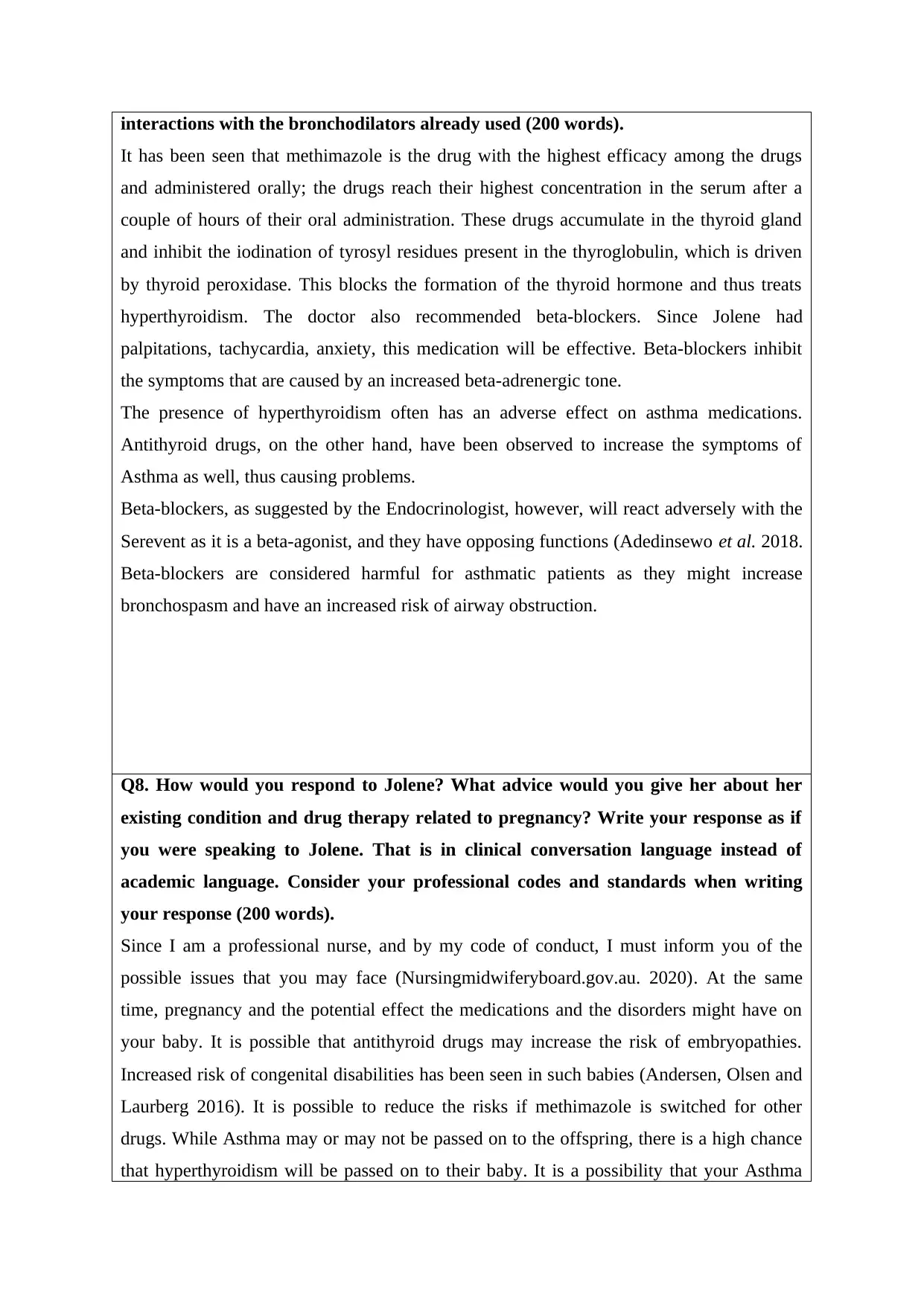
interactions with the bronchodilators already used (200 words).
It has been seen that methimazole is the drug with the highest efficacy among the drugs
and administered orally; the drugs reach their highest concentration in the serum after a
couple of hours of their oral administration. These drugs accumulate in the thyroid gland
and inhibit the iodination of tyrosyl residues present in the thyroglobulin, which is driven
by thyroid peroxidase. This blocks the formation of the thyroid hormone and thus treats
hyperthyroidism. The doctor also recommended beta-blockers. Since Jolene had
palpitations, tachycardia, anxiety, this medication will be effective. Beta-blockers inhibit
the symptoms that are caused by an increased beta-adrenergic tone.
The presence of hyperthyroidism often has an adverse effect on asthma medications.
Antithyroid drugs, on the other hand, have been observed to increase the symptoms of
Asthma as well, thus causing problems.
Beta-blockers, as suggested by the Endocrinologist, however, will react adversely with the
Serevent as it is a beta-agonist, and they have opposing functions (Adedinsewo et al. 2018.
Beta-blockers are considered harmful for asthmatic patients as they might increase
bronchospasm and have an increased risk of airway obstruction.
Q8. How would you respond to Jolene? What advice would you give her about her
existing condition and drug therapy related to pregnancy? Write your response as if
you were speaking to Jolene. That is in clinical conversation language instead of
academic language. Consider your professional codes and standards when writing
your response (200 words).
Since I am a professional nurse, and by my code of conduct, I must inform you of the
possible issues that you may face (Nursingmidwiferyboard.gov.au. 2020). At the same
time, pregnancy and the potential effect the medications and the disorders might have on
your baby. It is possible that antithyroid drugs may increase the risk of embryopathies.
Increased risk of congenital disabilities has been seen in such babies (Andersen, Olsen and
Laurberg 2016). It is possible to reduce the risks if methimazole is switched for other
drugs. While Asthma may or may not be passed on to the offspring, there is a high chance
that hyperthyroidism will be passed on to their baby. It is a possibility that your Asthma
It has been seen that methimazole is the drug with the highest efficacy among the drugs
and administered orally; the drugs reach their highest concentration in the serum after a
couple of hours of their oral administration. These drugs accumulate in the thyroid gland
and inhibit the iodination of tyrosyl residues present in the thyroglobulin, which is driven
by thyroid peroxidase. This blocks the formation of the thyroid hormone and thus treats
hyperthyroidism. The doctor also recommended beta-blockers. Since Jolene had
palpitations, tachycardia, anxiety, this medication will be effective. Beta-blockers inhibit
the symptoms that are caused by an increased beta-adrenergic tone.
The presence of hyperthyroidism often has an adverse effect on asthma medications.
Antithyroid drugs, on the other hand, have been observed to increase the symptoms of
Asthma as well, thus causing problems.
Beta-blockers, as suggested by the Endocrinologist, however, will react adversely with the
Serevent as it is a beta-agonist, and they have opposing functions (Adedinsewo et al. 2018.
Beta-blockers are considered harmful for asthmatic patients as they might increase
bronchospasm and have an increased risk of airway obstruction.
Q8. How would you respond to Jolene? What advice would you give her about her
existing condition and drug therapy related to pregnancy? Write your response as if
you were speaking to Jolene. That is in clinical conversation language instead of
academic language. Consider your professional codes and standards when writing
your response (200 words).
Since I am a professional nurse, and by my code of conduct, I must inform you of the
possible issues that you may face (Nursingmidwiferyboard.gov.au. 2020). At the same
time, pregnancy and the potential effect the medications and the disorders might have on
your baby. It is possible that antithyroid drugs may increase the risk of embryopathies.
Increased risk of congenital disabilities has been seen in such babies (Andersen, Olsen and
Laurberg 2016). It is possible to reduce the risks if methimazole is switched for other
drugs. While Asthma may or may not be passed on to the offspring, there is a high chance
that hyperthyroidism will be passed on to their baby. It is a possibility that your Asthma
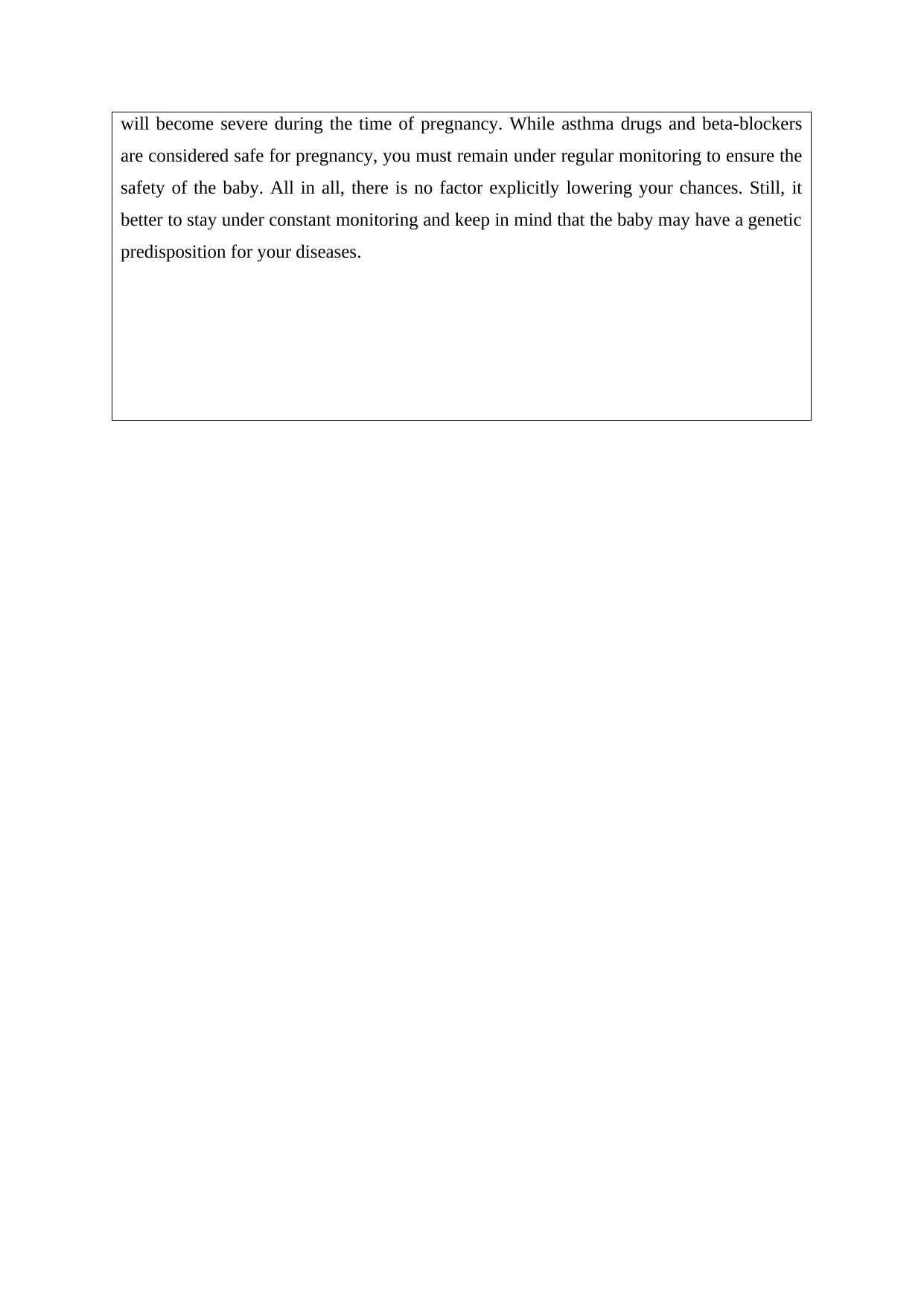
will become severe during the time of pregnancy. While asthma drugs and beta-blockers
are considered safe for pregnancy, you must remain under regular monitoring to ensure the
safety of the baby. All in all, there is no factor explicitly lowering your chances. Still, it
better to stay under constant monitoring and keep in mind that the baby may have a genetic
predisposition for your diseases.
are considered safe for pregnancy, you must remain under regular monitoring to ensure the
safety of the baby. All in all, there is no factor explicitly lowering your chances. Still, it
better to stay under constant monitoring and keep in mind that the baby may have a genetic
predisposition for your diseases.
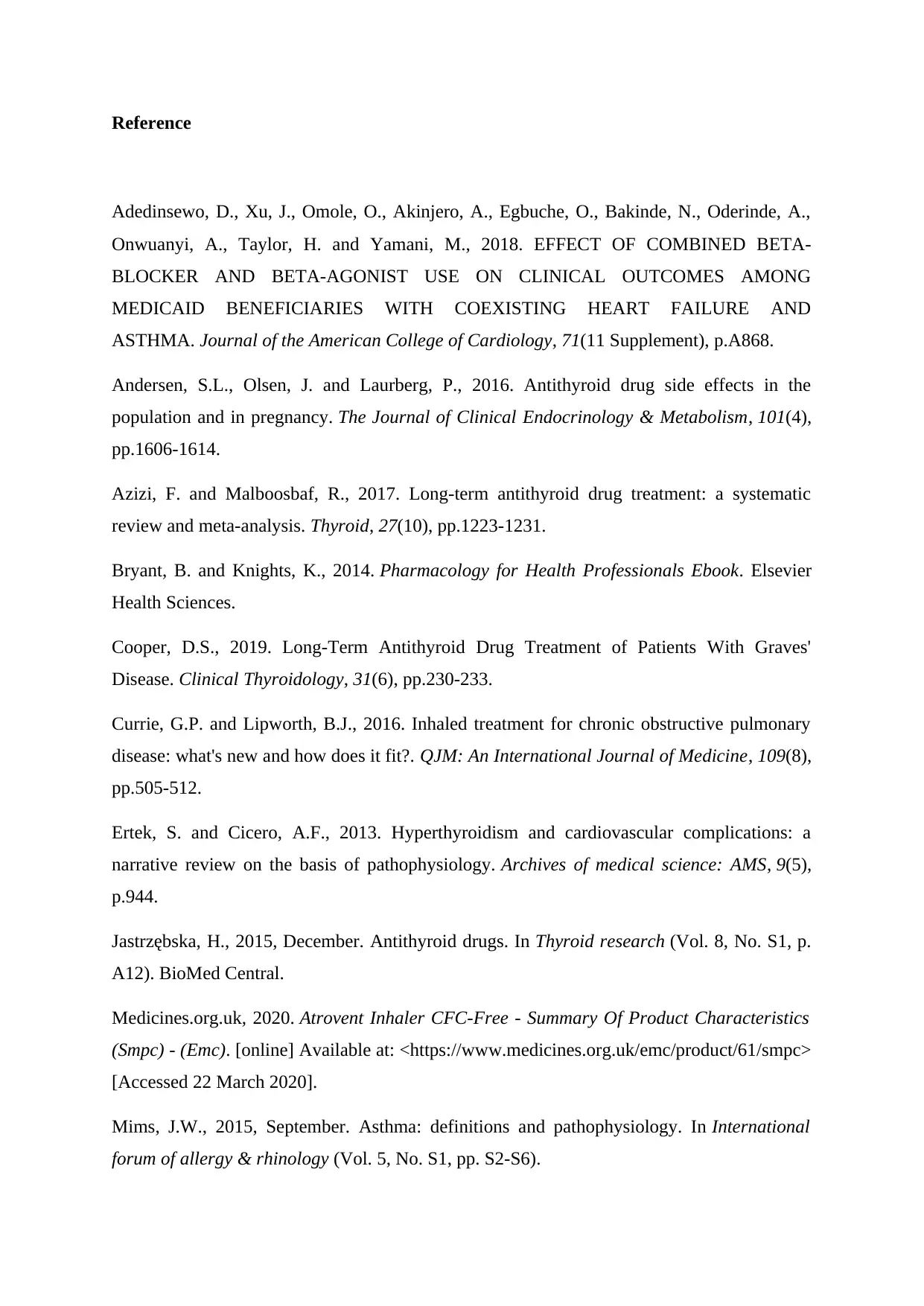
Reference
Adedinsewo, D., Xu, J., Omole, O., Akinjero, A., Egbuche, O., Bakinde, N., Oderinde, A.,
Onwuanyi, A., Taylor, H. and Yamani, M., 2018. EFFECT OF COMBINED BETA-
BLOCKER AND BETA-AGONIST USE ON CLINICAL OUTCOMES AMONG
MEDICAID BENEFICIARIES WITH COEXISTING HEART FAILURE AND
ASTHMA. Journal of the American College of Cardiology, 71(11 Supplement), p.A868.
Andersen, S.L., Olsen, J. and Laurberg, P., 2016. Antithyroid drug side effects in the
population and in pregnancy. The Journal of Clinical Endocrinology & Metabolism, 101(4),
pp.1606-1614.
Azizi, F. and Malboosbaf, R., 2017. Long-term antithyroid drug treatment: a systematic
review and meta-analysis. Thyroid, 27(10), pp.1223-1231.
Bryant, B. and Knights, K., 2014. Pharmacology for Health Professionals Ebook. Elsevier
Health Sciences.
Cooper, D.S., 2019. Long-Term Antithyroid Drug Treatment of Patients With Graves'
Disease. Clinical Thyroidology, 31(6), pp.230-233.
Currie, G.P. and Lipworth, B.J., 2016. Inhaled treatment for chronic obstructive pulmonary
disease: what's new and how does it fit?. QJM: An International Journal of Medicine, 109(8),
pp.505-512.
Ertek, S. and Cicero, A.F., 2013. Hyperthyroidism and cardiovascular complications: a
narrative review on the basis of pathophysiology. Archives of medical science: AMS, 9(5),
p.944.
Jastrzębska, H., 2015, December. Antithyroid drugs. In Thyroid research (Vol. 8, No. S1, p.
A12). BioMed Central.
Medicines.org.uk, 2020. Atrovent Inhaler CFC-Free - Summary Of Product Characteristics
(Smpc) - (Emc). [online] Available at: <https://www.medicines.org.uk/emc/product/61/smpc>
[Accessed 22 March 2020].
Mims, J.W., 2015, September. Asthma: definitions and pathophysiology. In International
forum of allergy & rhinology (Vol. 5, No. S1, pp. S2-S6).
Adedinsewo, D., Xu, J., Omole, O., Akinjero, A., Egbuche, O., Bakinde, N., Oderinde, A.,
Onwuanyi, A., Taylor, H. and Yamani, M., 2018. EFFECT OF COMBINED BETA-
BLOCKER AND BETA-AGONIST USE ON CLINICAL OUTCOMES AMONG
MEDICAID BENEFICIARIES WITH COEXISTING HEART FAILURE AND
ASTHMA. Journal of the American College of Cardiology, 71(11 Supplement), p.A868.
Andersen, S.L., Olsen, J. and Laurberg, P., 2016. Antithyroid drug side effects in the
population and in pregnancy. The Journal of Clinical Endocrinology & Metabolism, 101(4),
pp.1606-1614.
Azizi, F. and Malboosbaf, R., 2017. Long-term antithyroid drug treatment: a systematic
review and meta-analysis. Thyroid, 27(10), pp.1223-1231.
Bryant, B. and Knights, K., 2014. Pharmacology for Health Professionals Ebook. Elsevier
Health Sciences.
Cooper, D.S., 2019. Long-Term Antithyroid Drug Treatment of Patients With Graves'
Disease. Clinical Thyroidology, 31(6), pp.230-233.
Currie, G.P. and Lipworth, B.J., 2016. Inhaled treatment for chronic obstructive pulmonary
disease: what's new and how does it fit?. QJM: An International Journal of Medicine, 109(8),
pp.505-512.
Ertek, S. and Cicero, A.F., 2013. Hyperthyroidism and cardiovascular complications: a
narrative review on the basis of pathophysiology. Archives of medical science: AMS, 9(5),
p.944.
Jastrzębska, H., 2015, December. Antithyroid drugs. In Thyroid research (Vol. 8, No. S1, p.
A12). BioMed Central.
Medicines.org.uk, 2020. Atrovent Inhaler CFC-Free - Summary Of Product Characteristics
(Smpc) - (Emc). [online] Available at: <https://www.medicines.org.uk/emc/product/61/smpc>
[Accessed 22 March 2020].
Mims, J.W., 2015, September. Asthma: definitions and pathophysiology. In International
forum of allergy & rhinology (Vol. 5, No. S1, pp. S2-S6).
Paraphrase This Document
Need a fresh take? Get an instant paraphrase of this document with our AI Paraphraser
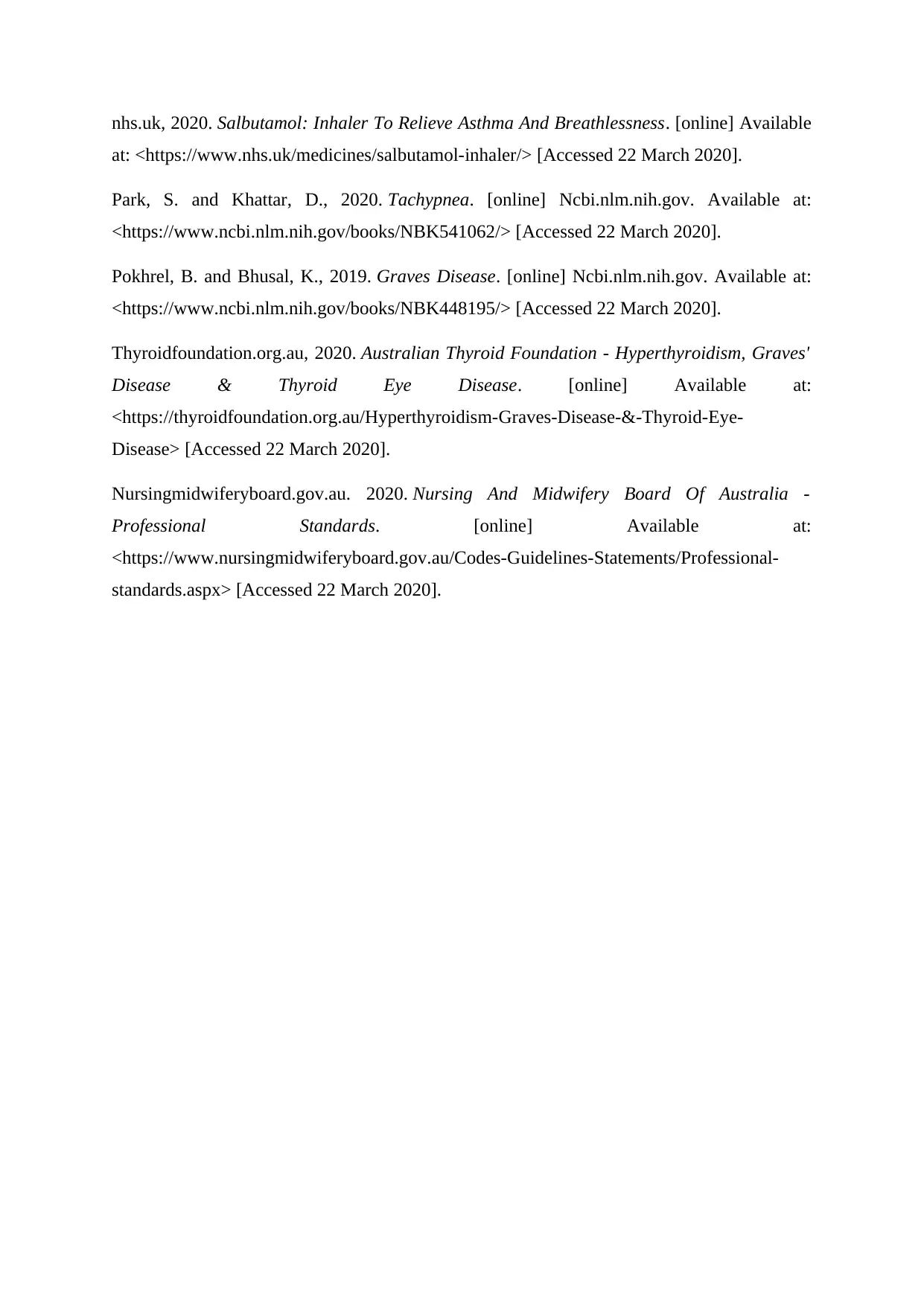
nhs.uk, 2020. Salbutamol: Inhaler To Relieve Asthma And Breathlessness. [online] Available
at: <https://www.nhs.uk/medicines/salbutamol-inhaler/> [Accessed 22 March 2020].
Park, S. and Khattar, D., 2020. Tachypnea. [online] Ncbi.nlm.nih.gov. Available at:
<https://www.ncbi.nlm.nih.gov/books/NBK541062/> [Accessed 22 March 2020].
Pokhrel, B. and Bhusal, K., 2019. Graves Disease. [online] Ncbi.nlm.nih.gov. Available at:
<https://www.ncbi.nlm.nih.gov/books/NBK448195/> [Accessed 22 March 2020].
Thyroidfoundation.org.au, 2020. Australian Thyroid Foundation - Hyperthyroidism, Graves'
Disease & Thyroid Eye Disease. [online] Available at:
<https://thyroidfoundation.org.au/Hyperthyroidism-Graves-Disease-&-Thyroid-Eye-
Disease> [Accessed 22 March 2020].
Nursingmidwiferyboard.gov.au. 2020. Nursing And Midwifery Board Of Australia -
Professional Standards. [online] Available at:
<https://www.nursingmidwiferyboard.gov.au/Codes-Guidelines-Statements/Professional-
standards.aspx> [Accessed 22 March 2020].
at: <https://www.nhs.uk/medicines/salbutamol-inhaler/> [Accessed 22 March 2020].
Park, S. and Khattar, D., 2020. Tachypnea. [online] Ncbi.nlm.nih.gov. Available at:
<https://www.ncbi.nlm.nih.gov/books/NBK541062/> [Accessed 22 March 2020].
Pokhrel, B. and Bhusal, K., 2019. Graves Disease. [online] Ncbi.nlm.nih.gov. Available at:
<https://www.ncbi.nlm.nih.gov/books/NBK448195/> [Accessed 22 March 2020].
Thyroidfoundation.org.au, 2020. Australian Thyroid Foundation - Hyperthyroidism, Graves'
Disease & Thyroid Eye Disease. [online] Available at:
<https://thyroidfoundation.org.au/Hyperthyroidism-Graves-Disease-&-Thyroid-Eye-
Disease> [Accessed 22 March 2020].
Nursingmidwiferyboard.gov.au. 2020. Nursing And Midwifery Board Of Australia -
Professional Standards. [online] Available at:
<https://www.nursingmidwiferyboard.gov.au/Codes-Guidelines-Statements/Professional-
standards.aspx> [Accessed 22 March 2020].
1 out of 8
Related Documents
Your All-in-One AI-Powered Toolkit for Academic Success.
+13062052269
info@desklib.com
Available 24*7 on WhatsApp / Email
![[object Object]](/_next/static/media/star-bottom.7253800d.svg)
Unlock your academic potential
© 2024 | Zucol Services PVT LTD | All rights reserved.





